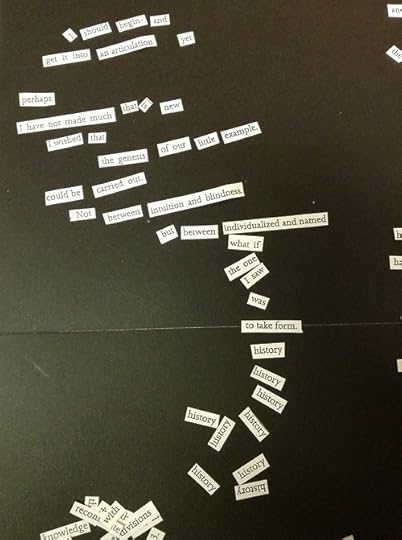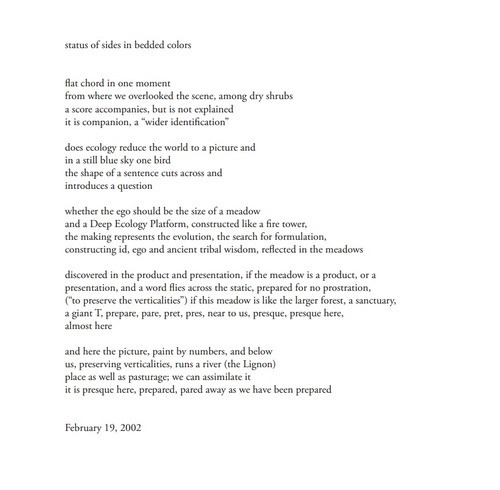C.J. Martin's Blog, page 61
March 5, 2013
Laura Moriarty’s talk from the Berkeley Conference on...
Laura Moriarty’s talk from the Berkeley Conference on Ecopoetics
February 28, 2013
Untitled #14, 2-5-13
(For a forthcoming broadside collaboration...
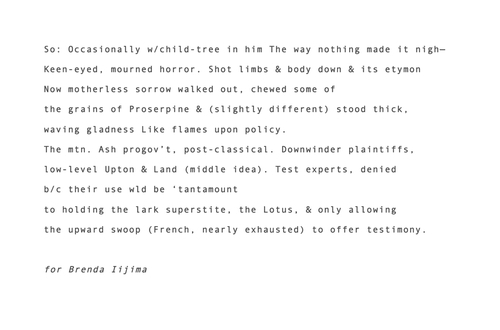
Untitled #14, 2-5-13
(For a forthcoming broadside collaboration w/Brenda—had a chance to hear her read from a soon-to-be-released book that totally knocked my socks off last week)
February 27, 2013
C.J. Martin -- Geologic Time (Bomb): Helen Adam's Superstitious Activism
Michael just posted a copy of my talk from the conference, and I just heard from Stephen Novotny that he’s in the process of uploading audio from some of the panels. More to come here.
mannemo:
Cutting up Michel Foucault’s Foreword to the English...
February 26, 2013
Laura Moriarty || Notes Toward an Ecology of Time
Michael Cross is posting contributions to last weekend’s Conference on Ecopoetics at Berkeley over at Disinhibitor. I’ll post some notes of my own here whenever I get a chance. In the meantime, enjoy!
February 19, 2013
Tyrone Williams, poems from LRL4. If all goes according to plan,...

Tyrone Williams, poems from LRL4. If all goes according to plan, we’ll be in the audience when Tyrone reads w/Brenda Iijima & Rob Halpern on Thursday night in Berkeley! More after the conference…
February 17, 2013
Darkness (Chapter 1), by Yedda Morrison (LRL e-editions,...
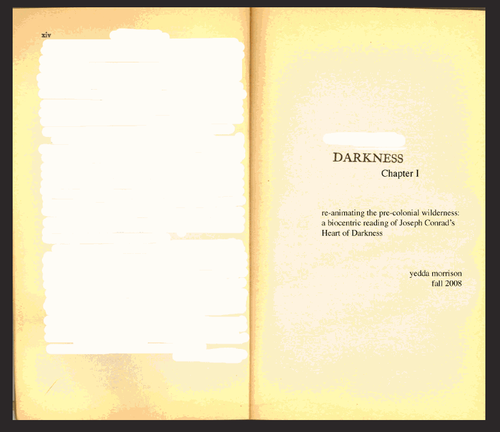
Darkness (Chapter 1), by Yedda Morrison (LRL e-editions, 2009). If you want to check out the entire project (ours is an excerpt), it was published by Make Now last year; here’s the SPD page for that book.
February 15, 2013
February 14, 2013
Brenda Iijima Interview in LRL5
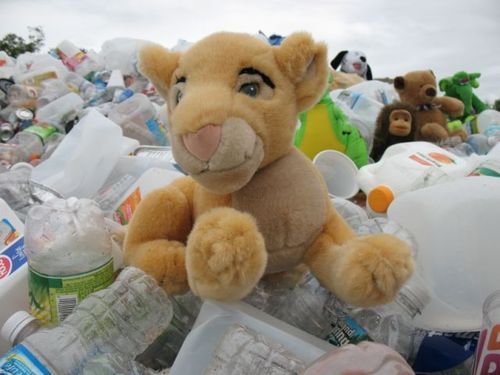
Thomas Fink: Our focus is Brenda Iijima’s new book, revv. you’ll—ution (Ann Arbor, Chicago, Olympia: Displaced Press, 2009). Let’s begin with the title and titles. “Revv”: revving an engine to get somewhere and make pollution? “Revving up” one’s revolutionary action (i.e. ecofeminist), as in “you’ll” take responsibility to put your energy toward a sustainable future? And then we have the boldfaced titles adorning pages or sections of the book: the interspersing of “rev,” “raw,” and “this is this,” with other, non-bolded titles frequently underneath. Would you care to help your readers contextualize all this?
Brenda Iijima: One way to explain the title is this: when I started working on revv. you’ll—ution I was simultaneously reading texts that have to do with prehistoric civilizations and the contemporary process of recovering social history through archeological practices—books like André Leroi-Gourhan’s Prehistoric Man, Frank C. Hibben’s Digging Up America and George Bataille’s The Cradle of Humanity. Also on my reading list were books about revolution: The Black Jacobins by C. L. R. James, A Genealogy of Resistanceby M. Nourbese Philip and The Many Headed Hydra by Peter Linebaugh and Marcus Rediker. My writing took the form of spelunking retro emergence as evidenced in homo sapien roots, cave people, burials, excavations, quaking under layers, body sensing and incarceration, etc. by filtering through the concept of revolution with all its varied implications. The intensity of how a fragment of a simple domestic object, usually mundane or a swatch of something acts as a vital clue in understanding what early life for humans involved. I began to think about how, during our present times, we are digging up remains with great care and much contemplation while also dumping epic amounts of our personal consumer waste (as well as industrial waste), and this waste is going unexamined. Staggering amounts of toxic waste—the notion of disposability has become so prevalent, the norm. Of course, it is obvious that nuclear waste is detrimental, but what about seemingly innocuous things; anything becomes a problem when we “dispose of” it. Are we not performing a sort of collective genocide with our dumping of processed substances? How are we as humans taking stock of what we cast aside? How are we mutating out of and into? I’m interested in rejected ideologies, ideas, conventions, modes of doing that accompany these conglomerated masses of material. Then there’s the digging through the rubble of catastrophe, a blend of human beings and nature acting in tandem to create disasters like those that occurred (are occurring) in Haiti and the Gulf Coast.
The cobbled together word, revv. you’ll—ution conjures for me the sonic impression of a whirlpool: a swirling together of the detritus that floats along until it tangles together forming a new mass. The revving up or acceleration of these pressing issues of the environment have immense social consequence, the you’ll, or how you—meaning everyone, every citizen-person with a will, what will she, he, zie “do”—what actions will take place as resistance or as daily existence. The book attempts to cobble together social agency. “Ution” is a suffix that beckons multiple interpretations. The following words in English have this ending—it’s important to see them:
ablution, absolution, adlocution, advolution, allocution, antipollution, assecution, attribution, caution, circumlocution, circumvolution, collocation, comminution, consecution, constitution, contribution, convolution, counterrevolution, destitution, devolution, dilution, diminution, dissolution, distribution, distributution, electrocution, elocution, evolution, execution, exolution, exolution, imbution, imminution, incaution, inexecution, insecution, institution, interlocution, intervolution, involution, irresolution, locution, malexecution, nondistribution, noneecution, nonsolution, persecution, pollution, precaution, prosecution, prostitution, reconstitution, redargution, redistribution, reinstitution, resolution, restitution, retribution, revolution, solution, subinvolution, substitution, superinstitution, ventrilocution, volution.
The title signifies a shifting focus while also suggesting interconnectedness and personal involvement. The “rev,” “raw,” and “this is this” are meant to be registers signaling shifts in the way perception is engaged. The This is: This register occurred to me while I was sitting in meditation at a Burmese Buddhist temple across the road from where I live, here in Brooklyn. The Buddhist idea that everything is exactly as it is informed this writing.
Fink: I’m not familiar with that Buddhist idea. Does it come from a particular sutra? Could you explain it further?
Iijima: That last sentence was a gross generalization on my part; I should have clarified! Here I’m simply positing the openness of Buddhist philosophy. That reality is exactly as “is”—in the face of delusions and misrecognitions that arise because desire and sensory cues throw us off—yet sensuality and desire are “is” also, simultaneously. Nagarjuna, in his great text, Fundamental Verses on the Middle Way states, “Everything is actual, or not actual, or actual and not actual. Everything is actual, or not actual.” (18:6-2) This path toward heightened perception isn’t accomplished through judgment, rather, through lived experience. Like Trungpa Rinpoches states, “As far as the warrior’s steps go, there is no defeat at all, there are no mistakes at all. Both positive and negative are the path, the general pattern. Any negative experience which occurs is an invitation or vanguard of positive experiences, as well. It just happens that way” (Chögyam Trungpa, Transcending Madness, Shambhala Press, 113). This “is” is a bountiful condition. “Exactly as is” means to me that presence wholly engulfs us, or we are wholly engulfed by presence which is a continuum of flux. Reality is exactly what we experience but not necessary exactly what we perceive. Contrast this to Martin Heidegger and the complications his work raises. His stance introduces a bold ontological doubt that is very much a Western cultural construct. For example, what he asks in Being and Time, “Is the phenomenon of conscience still recognizable at all, as it “really” is, in our interpretation? Have we not been all too sure of ourselves in the ingenuousness with which we deduced an idea of conscience from the constitution of being of Da-sein?” and he continues on, “If we are to assure ourselves of a way of access that will make such a step possible even for the vulgar understanding of conscience, we need explicit evidence for the connection between the results of the ontological analysis and the everyday experiences of conscience” (289). This “is” is a major subject matter of revv. you’ll—ution. “This is this” refers to the composite nature of “is”. Language is a forcing of conceptual categorization, and these categorizations undergo renegotiation at every psychosomatic linguistic turn.
Fink: There are three photographic essays, shot in your home town of North Adams, Massachusetts, in revv. you’ll—tion. They all have an important narrative component: two involve the proliferation of stuffed animals and a displacement of the beings of “the wild,” and the other is a quasi-reenactment of the violent abduction of a woman in 1982. Your mother and a childhood friend are the “actors” in these photo-dramas. First of all, how do you invest significance in the participation of these particular “actors”?
Iijima: My mom ends up collaborating with me on various projects because she is willing and available—she earnestly dives right in and lends great energy. Working together with her opens up channels of communication about diverse themes and places us in situations that necessitate embodied responses. We break through layers of sublimation by challenging our personal ethics and that line of friction where things differ between us. It is downright provocative for me to engage with my mother in action—it is like a primal need to see her participation. The mysteriousness of the fact that she is my mother begins to unravel.
In this particular series, my mom and I began working on some of the choreography and site specificity for these various intersecting documentary photo dramas when I thought of asking Tammy Fortin if she’d participate also—she was visiting North Adams from San Francisco. Tammy is my childhood friend and we grew up a few houses apart on Notch Road in North Adams. Reading gestural affect through mother and childhood friend is incredibly intimate. It was really informative to see them working together. We feel we have to challenge the constituted world head on. We have performed these gestures since youth—all this circumstance and information in our brains-bodies have accumulated. My newly rekindled friendship with Tammy blasted through the solidified past in paramount ways. There’s a new possibility for ‘site’ and ‘space’ that’s opened up. There is the past, and now there is also the past as we synthesize it. Something to do with the future anterior gets activated. We are out to crack the epigenetic codes of our childhood ecosystem. We are making meanings and lodging them in the earth and in the social surround.
Fink: Could you give an example of this “line of friction” or difference in ethical positions and how it was generative in the process of this collaboration?
Iijima: These are issues that are, of course so hard to talk about and I’d feel accusatory doing so—that’s why it is more holistic to perform this issues. Some of the friction has to do with the accumulated fall out and frustrations of growing up in a very economically depressed town. There was a lot of violence and dysfunction. We tend to argue about how we experienced the poverty and violence. I guess it has to do with acknowledging each other’s lived histories and coping mechanisms and responses. My mother values tough individualism. I find myself clashing with her in discussions we have concerning will and personal responsibility, for example. She takes a less fervent position on environmental issues than I do. Art interventions soften the criticisms and make for more open dialogue across lines as we work collaboratively in an experiential moment. A lot of feelings are triggered when my mother is involved.
Fink: As you shaped the text into a book, how did you conceive of the photographic sections as being in dialogue with one another and with the poetry?
Iijima: Brian Whitener, one of the editors at Displaced Press, offered up this great, open proposal—that I should feel free to engage fully with conceptual aspects of the book, so I began to think of the book as performed space—choreography and notes to/for/with the body. I had submitted the final version to Displaced Press when it occurred to me that the photo work I was doing at the time fit in deeply with revv. you’ll—ution’smotivations. The photos are witness to the words. The words are absorbed by the photos. Entering a different format for the eye changes cognition. And, what is the female gaze? I was (am) conducting simultaneous research concerning women who were murdered in North Adams during the 1970s when I was growing up there. There’s a spillover happening. These concerns couldn’t be held in compartmentalization. For a while I thought the book might become a script of sorts that could lead to the engagement with various sites, and these sites could lead back to the book, but this was too stiff; it didn’t contend with the tumultuousness of the content. It would have felt too abstract and spectral. So the book is a writing with. The municipal landfill is a place I spent a lot of time with my mother during my childhood—she had me sort through trash for materials we could recycle. It pained her to see so much resource being wasted. We’d do this on a weekly basis. Some of the photos were taken behind my parents’ house—land that is state forest, land that contains layers and layers of social history and also direct personal signification. What would be the inverse of exploring?
February 13, 2013
opened by customs: Next Big Thing
With Thanks to Arielle Guy por la tag!
What is the working title of the book?
The title is FEEDING THE BABY.
Where did the idea come from for the book?
The idea came from my son being old enough to sit in a highchair and eat. Which meant entertain himself. Which meant I was able…
C.J. Martin's Blog
- C.J. Martin's profile
- 11 followers


